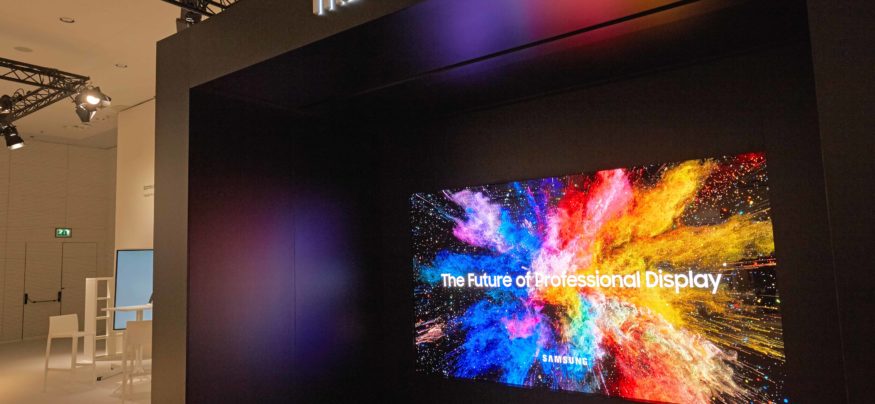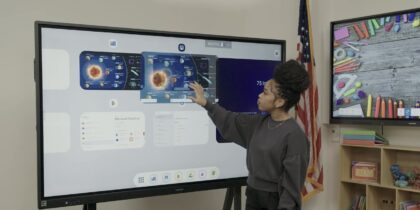When veterans of the AV industry bump into each other between the displays or after hours at InfoComm — the biggest trade show in their business — they’re going to share some thoughts about the latest and greatest tech they’ve seen. We’re confident that in 2018, a lot of them will mention The Wall Professional.
The microLED display wall that Samsung launched at CES in Las Vegas in early January, and showed a few weeks later at Integrated Systems Europe in Amsterdam, looks like it’s going to draw the same sort of three and four people-deep viewing crowds it had all day long at those shows.
That’s because The Wall Professional is very different from just about any other LED display that AV pros and end users will see at the show. Scores of companies, including Samsung, will show the latest versions of indoor LED screens manufactured with conventional processes.
The technology behind The Wall is different, though, and it foreshadows how premium LED displays will be built in the future.
What You See Now
The standard indoor LED displays that are starting to displace LCDs as the main option for large-scale video walls consist of millions of tiny LED chip packages — each with their own addressable light source — that are surface-mounted and wired, one by one, to backplate modules. The more chips that the maker can pack together into a grid, the higher the resolution delivered by each of the individual modules, stacked and tiled together to form large-scale video walls.
The highest resolution display products have gaps between the chip packages of 1mm or even less — about the width of a dime on its edge. Packing that many LEDs means a corresponding increase in the cost of the components and the manufacturing time it takes for high-speed robotics machines to place the chips.
Even at a fine 1mm pitch, the resulting product will still display the sharpest image while viewing at a distance of 7-10 feet. Any closer, and you start to see the individual LEDs.
The viewing experience, even up close, is different with The Wall Professional — not just because the individual pixels are only 0.8mm across, but also because the display uses a new process to produce microLEDs.
Scaling the Wall
With microLED technology, micrometer-scale LEDs deliver a viewing experience that’s unmatched by current technology.
Without getting too technical, let’s just say the process to transfer these smaller chips into LED modules and walls differs from the conventional process. The result is essentially screen tiles — reminiscent of the shape of wall tiles — comprised of mass-transferred clusters of almost microscopic lights.
Mounted together as a uniform canvas and plugged in, they create a visual experience similar to what you get with premium QLED TVs. Each of those tiny light sources is controlled — meaning each light can be dynamically turned on and off to deliver true blacks, and deliver the same High Dynamic Range (HDR) capabilities of today’s premium UHD TVs.
How to Plan and Deploy LED Digital Signage
Discover the unique advantages of direct-view LED technology over traditional LCD displays. Download Now
Where the microLED tech of The Wall Professional differs from using QLED or more conventional LCDs for large video walls is the absence of bezels around panel edges. LCD displays joined together inevitably create hairline grids that visually interrupt the content. The Wall, in its current iteration, creates a single 146-inch diagonal canvas — larger than any flat panel display on the market. Because it consists of clustered tiles, versions of The Wall can be any size, scale or shape a buyer demands.
The Wall’s launch model targets massive and large-scale installations, for applications where the buyer needs to create the maximum size and impact.
But microLED is also a technology that, with time and more manufacturing volume, will see commercial applications like high-profile digital signage in retail and public spaces, such as office tower lobbies and airport concourses.
Weighing Today’s Main Options
InfoComm 2018 visitors may be astonished by the range of options for surface mounted diode (SMD) indoor LED displays. Walking the show floor, you’ll see dozens of exhibiting companies showcasing LED products, some of them with lower prices when compared to the display brands more familiar to the North American market.
Most of them will tout products that, in pure specifications, would seem to match up favorably. But as the saying goes, the devil is in the details.
Samsung has a variety of options for fine pitch LED displays, and our business partners are winning a lot of projects because of how our products — like the IF series — hold to the highest manufacturing standards, as well as the way we support our resellers and end-user customers.
Here are some considerations you’ll want to have as a buyer or integrator as you weigh the many options on display in Las Vegas:
- Does the manufacturer have any North American-based customer support? (Not counting sales offices.)
- Is the product fully certified for use in the United States? (Not being FCC or UL approved can lead to some big legal problems.)
- Can the display be serviced from the front? (Rear-only servicing usually means far higher labor costs and long service disruptions.)
There are many other technical and operating questions buyers may want to ask. You can review our comprehensive LED signage white paper as a primer. You’ll save a lot of time, and avoid serious frustration down the road, by asking confident questions and making well-informed choices early on.
InfoComm can be a dizzying few days — a kaleidoscope of amazing display and collaboration technologies. Make a point of scheduling a visit and tour of Samsung’s booth in the Central Hall to see The Wall and other options from a top quality, trusted advisor on what’s new and what matters in today’s digital signage market.
Explore our full line of commercial display and digital signage solutions, from collaborative tech to video walls, ahead of InfoComm 2018.







